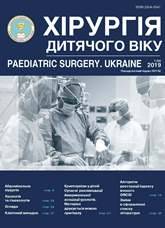Qualities of life of children with gallstone disease transferred a cholecystectomy in the early postoperative period living on subarctic region conditions
DOI:
https://doi.org/10.15574/PS.2019.64.8Keywords:
gallstone disease, cholecystitis, cholecystectomy, laparoscopy, quality of lifeAbstract
Research objective – to estimate in comparison in the early postoperative period quality of life of children with gallstone disease transferred the cholecystectomy executed with use of laparoscopic technologies of four port and uniform access in the early postoperative period.Materials and methods. 50 patients undergoing cholecystectomy through the use of laparoscopic technologies through four port and 50 patients in whom surgery was performed through a uniform access were examined.
Results and conclusions. The choice of laparoscopic technology of uniform access provides earlier decrease in expressiveness of a postoperative pain syndrome and restoration of a physical state, and also emotional background of the patient in the early postoperative period in comparison with a technique four port access.
The research was carried out in accordance with the principles of the Helsinki Declaration. The study protocol was approved by the Local Ethics Committee (LEC) of all participating institution. The informed consent of the patient was obtained for conducting the studies.
No conflict of interest was declared by the authors.
References
Alekseeva YuE, Kuramshin RR, Poddubny IV, Kharitonov LA. (2010). Clinical and pathogenetic features postcholecystectomy syndrome in children. Experimental and Clinical Gastroenterology. 1: 25-30.
Gould JL, Poola AS, St Peter SD, Aguayo P. (2016). Same day discharge protocol implementation trends in laparoscopic cholecystectomy in pediatric patients. Journal of Pediatric Surgery. 51; 12: 1936-1938. https://doi.org/10.1016/j.jpedsurg.2016.09.008; PMid:27666008
Jeanty CS, Derderian Chr, Courtier J, Hirose Sh. (2015). Clinical management of infantile cholelithiasis. Journal of Pediatric Surgery. 50;8: 1289-1292. https://doi.org/10.1016/j.jpedsurg.2014.10.051; PMid:25783306
Kharitonov LA. (2011). Therapeutic tactics for gallstone disease in children. Experimental and Clinical Gastroenterology. 1: 72-77.
Kharitonov LA, Zaprudnov AM, Bogomaz LV, Yakimov LV. (2012). Algorithm of staged observation of children with cholelithiasis. Practice of Pediatrician. 3: 18-22.
Langballe KO, Bardram L. (2014). Cholecystectomy in Danish children – A nationwide study. Journal of Pediatric Surgery. 49; 4: 626-630. https://doi.org/10.1016/j.jpedsurg.2013.12.019; PMid:24726126
Pimenova NV, Kaznacheev KS, Kaznacheeva LF. (2011). Children’s cholelithiasis. Practical Medicine. 5(53): 16-19.
Sattarova V, Eaton S, Hall NJ, Lapidus-Krol E, Zani A, Pierro A. (2016). Laparoscopy in pediatric surgery: Implementation in Canada and supporting evidence. Journal of Pediatric Surgery. 51; 5: 822–827. https://doi.org/10.1016/j.jpedsurg.2016.02.030; PMid:26944184
Trukhachev SV, Rumyantseva GN, Yeremeyev AG. (2013). Surgical treatment of children and young people with gallstone disease using modern technologies. Tver Medical Journal. 1: 88-102.
Tsap NA, Vinokurova NV, Trubitsyna IA, Komarova SYu. (2012). Laporoscopic cholecystectomy in children – is there room for discussion? Russian Bulletin of Pediatric Surgery, Anesthesiology and Resuscitation. 2;1: 25-28.
Downloads
Issue
Section
License
The policy of the Journal “PAEDIATRIC SURGERY. UKRAINE” is compatible with the vast majority of funders' of open access and self-archiving policies. The journal provides immediate open access route being convinced that everyone – not only scientists - can benefit from research results, and publishes articles exclusively under open access distribution, with a Creative Commons Attribution-Noncommercial 4.0 international license(СС BY-NC).
Authors transfer the copyright to the Journal “PAEDIATRIC SURGERY.UKRAINE” when the manuscript is accepted for publication. Authors declare that this manuscript has not been published nor is under simultaneous consideration for publication elsewhere. After publication, the articles become freely available on-line to the public.
Readers have the right to use, distribute, and reproduce articles in any medium, provided the articles and the journal are properly cited.
The use of published materials for commercial purposes is strongly prohibited.

